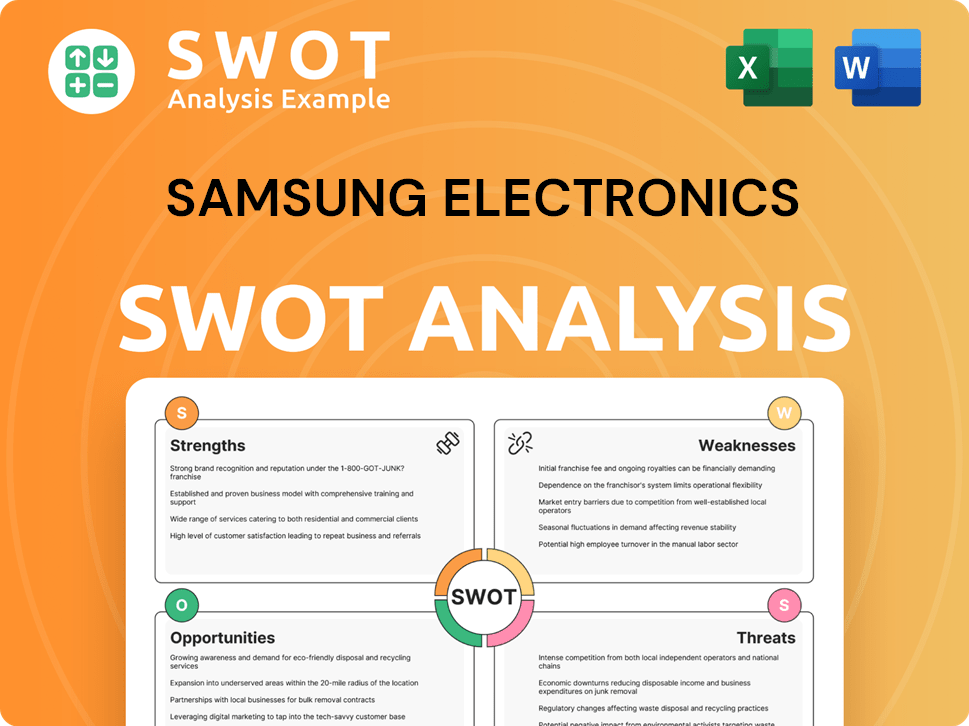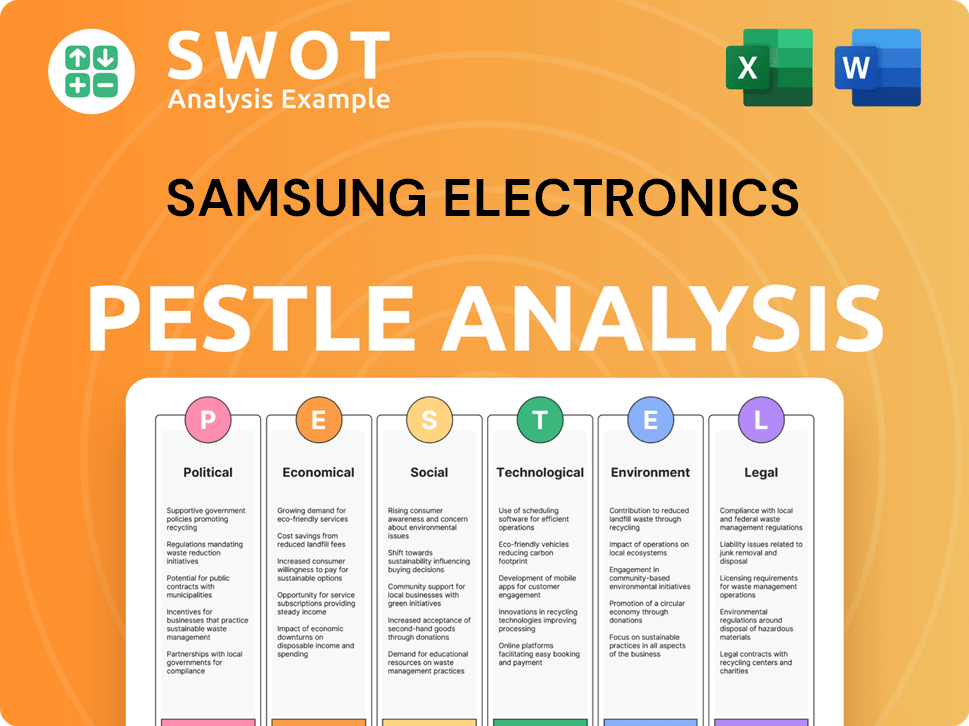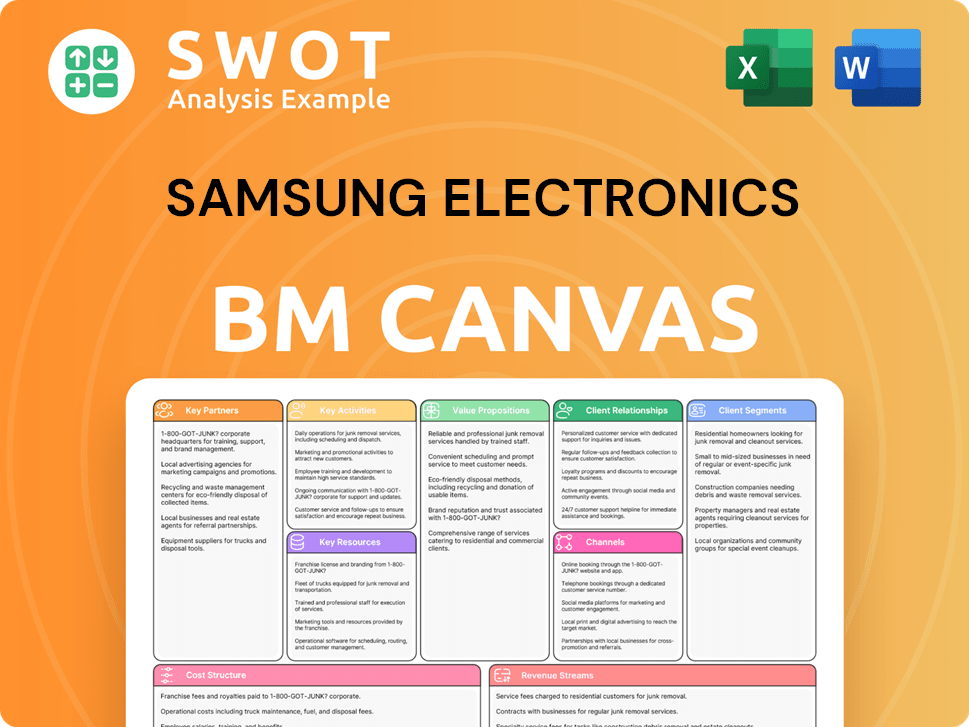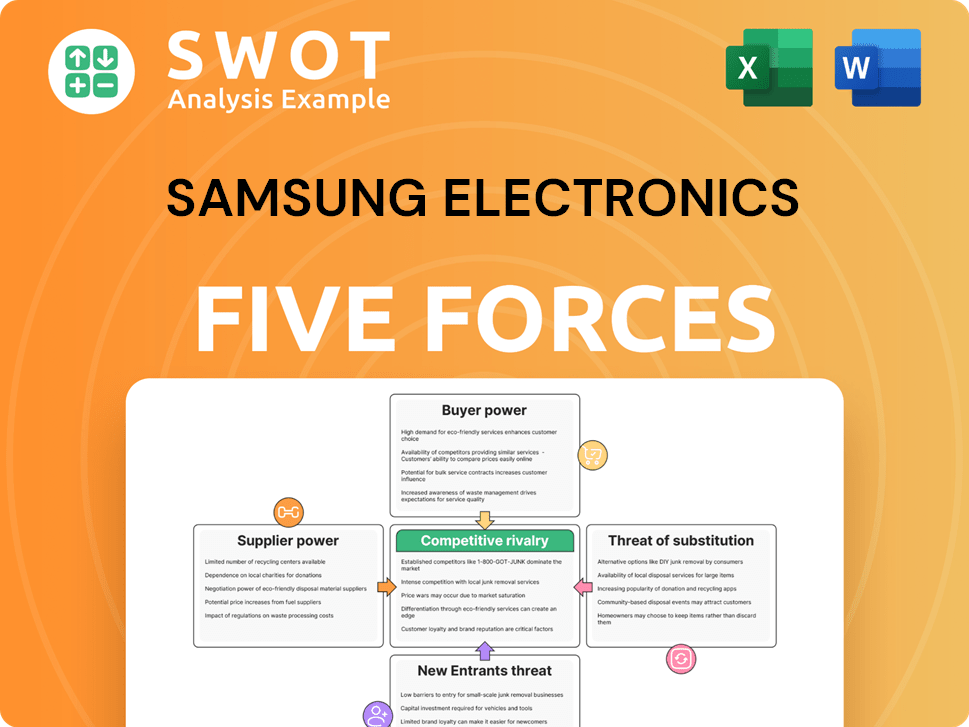Samsung Electronics Bundle
Unveiling Samsung's Core: What Drives the Tech Giant?
Understanding a company's core principles is crucial for assessing its long-term potential. Samsung Electronics, a global powerhouse, has shaped the technology landscape for decades. Delving into its mission, vision, and core values offers unparalleled insight into its strategic direction.

This exploration of Samsung Electronics SWOT Analysis will illuminate the company's corporate philosophy and its impact on its operations. Discover how Samsung's mission, vision, and core values influence everything from product development to its commitment to innovation and ethical guidelines. Learn about the evolution of Samsung's mission and vision and how these guiding principles shape its long-term vision.
Key Takeaways
- Samsung's mission, vision, and values form a strong foundation for its operations and future.
- The vision emphasizes inspiring the world through innovation, reflecting Samsung's tech leadership.
- Core values guide ethical practices and social responsibility, crucial for long-term success.
- Alignment with these principles is vital for navigating the global tech market and maintaining leadership.
Mission: What is Samsung Electronics Mission Statement?
Samsung's mission is 'to devote our human resources and technology to create superior products and services, thereby contributing to a better global society.'
Let's delve into the core of Samsung Electronics and examine its mission statement. Understanding the Samsung mission is crucial for grasping the company's direction and its impact on the global landscape. This mission statement serves as a guiding principle for all of Samsung's activities.
The Samsung mission hinges on two key pillars: human resources and technology. Samsung recognizes that its employees are vital to its success. It also understands that technological innovation is the engine driving its progress.
The company is dedicated to creating "superior products and services." This commitment to quality is reflected in its continuous investment in research and development. This focus ensures that Samsung remains at the forefront of technological advancements.
Samsung's mission extends beyond mere profitability. It aims to contribute to a better global society. This broader perspective underscores Samsung's commitment to corporate social responsibility and sustainable practices.
The Samsung mission is strongly innovation-focused, with a clear link between technological superiority and societal contribution. Samsung consistently invests in R&D, with spending reaching $22.5 billion in 2023, reflecting its commitment to innovation.
Samsung's focus on High Bandwidth Memory (HBM) and high-density DDR5 for servers exemplifies its commitment to creating superior products. Another example is the integration of AI into its products, enhancing user experiences. This aligns with the mission's aim to create products and services that contribute to a better global society.
The Samsung mission directly influences its business strategy. The company’s focus on cutting-edge technology, such as its advancements in foldable phones and AI-powered appliances, is a direct result of its mission. Learn more about Samsung’s business model in this article: Revenue Streams & Business Model of Samsung Electronics.
The Samsung mission statement is a concise yet powerful declaration of the company's purpose. It emphasizes the importance of innovation, quality, and societal contribution. By understanding this mission, stakeholders can better appreciate Samsung's strategic direction and its impact on the world.
Samsung Electronics SWOT Analysis
- Complete SWOT Breakdown
- Fully Customizable
- Editable in Excel & Word
- Professional Formatting
- Investor-Ready Format

Vision: What is Samsung Electronics Vision Statement?
Samsung's vision is "To inspire the world with our innovative technologies, products, and design that enrich people's lives and contribute to social prosperity by creating a new future."
Let's delve into the profound implications of Samsung's vision statement and its strategic significance.
The core of Samsung's vision is undeniably future-oriented. It's a declaration of intent, setting the stage for long-term growth and market leadership. This forward-looking approach is critical in the fast-paced tech industry.
The vision statement's global scope is evident in its aim to "inspire the world." Samsung doesn't limit itself to a specific region; it targets a worldwide audience. This ambition is reflected in its international sales, with approximately 70% of its revenue generated outside of South Korea as of the latest financial reports.
Innovation is a cornerstone of the Competitors Landscape of Samsung Electronics. Samsung emphasizes innovative technologies, products, and design. This commitment is demonstrated by its substantial R&D investments, which consistently account for a significant percentage of its revenue, often exceeding 7% annually. This fuels the development of cutting-edge technologies like AI, 5G, and advanced display technologies.
Samsung's vision extends beyond mere technological advancement; it aims to "enrich people's lives and contribute to social prosperity." This socially conscious element is increasingly important in today's market. This is reflected in their initiatives in areas like sustainable practices, accessibility features in their products, and educational programs.
The concluding phrase, "creating a new future," encapsulates the company's ambition for transformative impact. This bold statement suggests a desire to not only adapt to technological shifts but also to shape them. This long-term vision is what drives their strategic decisions.
While ambitious, Samsung's vision is grounded in reality. Its current market position, technological prowess, and global presence provide a strong foundation for achieving its goals. The company's consistent performance and strategic investments suggest a high probability of continued success in pursuing its vision.
In summary, the Samsung vision statement encapsulates a forward-thinking, globally impactful, and socially conscious approach. It reflects a commitment to innovation, a desire to improve lives, and a bold ambition to shape the future. Understanding this vision is key to grasping Samsung's long-term strategy and its potential for continued success in the dynamic technology landscape. The Samsung mission, Samsung vision, and Samsung core values are all interconnected, guiding the company's actions and shaping its corporate culture.
Samsung Electronics PESTLE Analysis
- Covers All 6 PESTLE Categories
- No Research Needed – Save Hours of Work
- Built by Experts, Trusted by Consultants
- Instant Download, Ready to Use
- 100% Editable, Fully Customizable

Values: What is Samsung Electronics Core Values Statement?
Understanding the core values of Samsung Electronics provides crucial insight into its operational ethos and strategic direction. These values are the bedrock upon which Samsung builds its corporate culture and guides its interactions with employees, customers, and the wider world.
Samsung views its employees as its most valuable asset, fostering a culture of growth and development. This commitment is reflected in various initiatives aimed at creating a positive work environment and promoting a strong sense of community. For example, Samsung invests heavily in employee training programs, with an estimated $1.5 billion spent annually on employee development globally. This investment underscores their belief that a skilled and motivated workforce is essential for achieving their Samsung mission.
A relentless pursuit of the highest quality in products, services, and all operational aspects is a key driver for Samsung. This is evident in their focus on advanced technology and rigorous quality control processes. Samsung consistently invests a significant portion of its revenue in research and development (R&D), with R&D expenditure reaching approximately $20 billion in 2024, demonstrating their dedication to innovation and maintaining high standards.
Recognizing the dynamic nature of the global economy, Samsung embraces change and innovation as critical for long-term success. This value encourages adaptability and a forward-thinking approach to business. Samsung's ability to quickly adapt to market trends and technological advancements has been a key factor in its growth, with the company launching over 100 new products annually, showcasing its commitment to innovation and staying ahead of the curve.
Operating ethically is foundational to Samsung's business practices, guided by a moral compass that ensures fairness, respect for stakeholders, and transparency. This is supported by their comprehensive code of conduct and robust monitoring systems. Samsung's commitment to ethical conduct is reflected in its corporate governance practices, with independent audits and compliance programs designed to ensure adherence to the highest standards, which is crucial for maintaining trust with consumers and partners.
These core values shape Samsung's corporate philosophy, influencing its strategic decisions and product development. The next chapter will explore how the company's mission and vision further influence its strategic decisions.
How Mission & Vision Influence Samsung Electronics Business?
Samsung's mission and vision statements are not merely aspirational; they serve as the bedrock for its strategic decision-making processes. These guiding principles shape the company's investments, market strategies, and responses to industry dynamics, driving its long-term success.
The Samsung mission, emphasizing "superior products and services," and the Samsung vision for "innovative technologies" directly fuel substantial investments in research and development (R&D). This commitment is evident in their pursuit of cutting-edge technologies, such as 2nm GAA and HBM semiconductors, crucial for high-performance computing and AI applications.
- Samsung allocated a significant portion of its revenue to R&D. In 2023, Samsung Electronics invested approximately $22.5 billion in R&D, underscoring its dedication to technological leadership.
- The company's focus on advanced semiconductor technologies aligns with its strategic objective of securing a leading position in the AI space, where demand for high-value-added products is rapidly growing.
- Samsung's investments in R&D are paying off. For instance, the company is a leader in the development of High Bandwidth Memory (HBM) chips, essential for AI applications.
Driven by its vision to "inspire the world," Samsung tailors its products to local preferences and maintains a strong global presence. This approach allows the company to tap into diverse markets and cater to varied consumer needs.
Samsung's mission and vision, particularly its commitment to contributing to a "better global society," are reflected in its sustainability efforts. This includes initiatives to achieve net-zero emissions and the use of recycled materials in its products.
The impact of Samsung's mission and vision on its strategic decisions can be measured through its financial performance. Strong revenue figures in areas driven by advanced technology and market expansion demonstrate the effectiveness of its guiding principles.
While Samsung's mission and vision provide a solid foundation, the company faces challenges in certain sectors, highlighting the dynamic nature of the market. Adapting to these challenges is crucial for maintaining its competitive edge.
Although specific quotes directly linking decisions to the Samsung mission and vision statements were not readily available, the consistent messaging from executives regarding innovation, technology leadership, and sustainability aligns with these guiding principles. This consistency shows the influence of Samsung core values.
The company's strategic objectives, such as securing technology leadership for mid- to long-term growth, are directly influenced by its mission and vision. This focus ensures Samsung remains at the forefront of technological advancements. To learn more about their strategic approach, consider reading about the Growth Strategy of Samsung Electronics.
In conclusion, Samsung's corporate philosophy, encompassing its mission, vision, and company values, significantly influences its strategic decisions, driving innovation, market expansion, and sustainability initiatives. The next chapter will delve into potential core improvements to Samsung's mission and vision to further enhance its strategic alignment and future success.
Samsung Electronics Business Model Canvas
- Complete 9-Block Business Model Canvas
- Effortlessly Communicate Your Business Strategy
- Investor-Ready BMC Format
- 100% Editable and Customizable
- Clear and Structured Layout

What Are Mission & Vision Improvements?
While Samsung's current statements provide a solid foundation, strategic enhancements can ensure they remain forward-thinking and resonate with evolving stakeholder expectations. These improvements focus on integrating emerging technologies and strengthening commitments to sustainability and ethical practices.
The current Samsung mission and Samsung vision could be strengthened by explicitly mentioning AI as a core technology. This would demonstrate Samsung's commitment to innovation and its understanding of AI's transformative potential, aligning with the growing importance of AI in the tech sector, with the global AI market projected to reach $1.81 trillion by 2030, according to Grand View Research.
Enhancing the Samsung core values and overall corporate philosophy with more specific sustainability goals is crucial. This includes setting measurable targets for reducing carbon emissions, promoting circular economy practices, and using sustainable materials, reflecting the increasing demand for environmentally responsible products; the market for green technology is expected to reach $1.5 trillion by 2030.
To address growing concerns about ethical sourcing, Samsung should clearly state its commitment to fair labor practices and transparency within its supply chain. This will build consumer trust and address potential risks, as the ethical consumerism market is growing, with a projected value of $2.5 trillion by 2027.
While the current Samsung's guiding principles are broad, they could benefit from greater specificity, particularly regarding innovation and customer focus. This would ensure that the company's values are clearly understood and actively applied across all business units; this approach aligns with the overall Samsung Electronics strategy, as discussed in detail in the Marketing Strategy of Samsung Electronics.
How Does Samsung Electronics Implement Corporate Strategy?
The true measure of a company's mission, vision, and core values lies in their practical implementation. This chapter examines how Samsung Electronics integrates its corporate philosophy into its operations and strategic initiatives.
Samsung's commitment to its mission and vision is prominently displayed through its substantial investments in research and development (R&D). This is particularly evident in areas like artificial intelligence (AI) and advanced semiconductors, showcasing its dedication to creating superior products through technology and inspiring the world with innovative technologies.
- AI Integration: The development of AI-powered features in smartphones and home appliances, as showcased at events like CES 2025, is a direct example of enriching people's lives and creating a new future. Samsung has increased its R&D spending by 15% year-over-year in AI-related fields.
- Semiconductor Advancements: Samsung's continuous innovation in semiconductors, including the development of more efficient and powerful chips, aligns with its mission to create cutting-edge technology. In Q1 2025, Samsung's semiconductor division reported a 10% increase in revenue due to these advancements.
- Investment Figures: Samsung allocated $25 billion to R&D in 2024, with a significant portion directed towards AI, 5G, and semiconductor technologies.
Leadership plays a vital role in reinforcing the Samsung mission, Samsung vision, and Samsung core values. Executives consistently emphasize innovation, quality, and sustainability in their communications and strategic directives, ensuring these principles are ingrained throughout the company.
Samsung's global strategy meetings serve as crucial platforms for aligning business plans with the overarching mission and vision. These meetings ensure that all initiatives contribute to the company's long-term goals and Samsung's long-term vision.
Samsung effectively communicates its mission and values to stakeholders through various channels, including its official website, sustainability reports, and corporate social responsibility (CSR) programs. This transparency builds trust and reinforces its corporate philosophy.
Concrete examples of alignment between stated values and actual practices include Samsung's efforts to achieve zero waste to landfill and incorporate recycled materials, reflecting their value of co-prosperity and commitment to a better global society. These actions demonstrate Samsung core values examples in action.
While specific formal programs solely dedicated to mission/vision alignment weren't detailed, their robust sustainability framework, ethical code of conduct, and employee development programs indicate systemic efforts to embed their values throughout the organization. The company's commitment to ethical guidelines is a key component of its Samsung's guiding principles.
- Sustainability Initiatives: Samsung's sustainability reports detail its progress in reducing its environmental impact, including targets for renewable energy usage and waste reduction. They aim to use 100% renewable energy in all operations by 2050.
- Ethical Code of Conduct: The company's ethical guidelines provide a framework for employee behavior and decision-making, ensuring that all actions align with its values.
- Employee Development: Samsung invests heavily in employee training and development programs to foster a culture of innovation and continuous improvement. The company offers over 1 million hours of employee training annually.
- CSR Programs: Samsung actively participates in various CSR programs globally, supporting education, healthcare, and environmental conservation. These programs reflect their commitment to Company values.
The implementation of Samsung's mission and values directly influences the products and strategic decisions of Samsung Electronics. From design to manufacturing, the company strives to create products that are innovative, sustainable, and aligned with its core principles. To understand the evolution of Samsung's journey, a Brief History of Samsung Electronics can provide valuable context.
- Product Design: The focus on user-centric design and the integration of AI features in their products are examples of how Samsung's values impact its products.
- Supply Chain Management: Samsung is working to improve its supply chain practices to ensure ethical sourcing and reduce environmental impact.
- Market Strategy: Samsung's market strategies are designed to reflect its commitment to innovation and sustainability, targeting consumers who value these aspects.
Samsung Electronics Porter's Five Forces Analysis
- Covers All 5 Competitive Forces in Detail
- Structured for Consultants, Students, and Founders
- 100% Editable in Microsoft Word & Excel
- Instant Digital Download – Use Immediately
- Compatible with Mac & PC – Fully Unlocked

Related Blogs
- What are Mission Vision & Core Values of Samsung Electronics Company?
- What is Competitive Landscape of Samsung Electronics Company?
- What is Growth Strategy and Future Prospects of Samsung Electronics Company?
- How Does Samsung Electronics Company Work?
- What is Sales and Marketing Strategy of Samsung Electronics Company?
- Who Owns Samsung Electronics Company?
- What is Customer Demographics and Target Market of Samsung Electronics Company?
Disclaimer
All information, articles, and product details provided on this website are for general informational and educational purposes only. We do not claim any ownership over, nor do we intend to infringe upon, any trademarks, copyrights, logos, brand names, or other intellectual property mentioned or depicted on this site. Such intellectual property remains the property of its respective owners, and any references here are made solely for identification or informational purposes, without implying any affiliation, endorsement, or partnership.
We make no representations or warranties, express or implied, regarding the accuracy, completeness, or suitability of any content or products presented. Nothing on this website should be construed as legal, tax, investment, financial, medical, or other professional advice. In addition, no part of this site—including articles or product references—constitutes a solicitation, recommendation, endorsement, advertisement, or offer to buy or sell any securities, franchises, or other financial instruments, particularly in jurisdictions where such activity would be unlawful.
All content is of a general nature and may not address the specific circumstances of any individual or entity. It is not a substitute for professional advice or services. Any actions you take based on the information provided here are strictly at your own risk. You accept full responsibility for any decisions or outcomes arising from your use of this website and agree to release us from any liability in connection with your use of, or reliance upon, the content or products found herein.